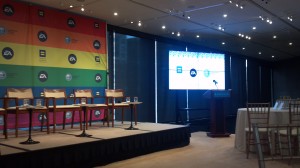Changing the conversation, not just the games
 Last week I attended the EA/HRC Full Spectrum mini-conference (more details here). As games journalist Leigh Alexander points out, the conference feels like a start. Having spent several years studying, thinking, and teaching about queer media representations and games, however, I spent most of the conference with a furrowed brow, torn between feelings of “progress” and frustration that even as things change things tend to stay the same.
Last week I attended the EA/HRC Full Spectrum mini-conference (more details here). As games journalist Leigh Alexander points out, the conference feels like a start. Having spent several years studying, thinking, and teaching about queer media representations and games, however, I spent most of the conference with a furrowed brow, torn between feelings of “progress” and frustration that even as things change things tend to stay the same.
In 2007, I conducted research on gay gamers (article here). Having gotten a sense of the audience side of the LGBT in game representation question, I decided to tackle the industry side. I complied a list of all the games I could find that had gay characters, queer themes, gender-bending, etc. (56 in all). I then went through and emailed all the publishers and developers still in operation. Most never responded. EA did respond to my email, nicely even, but essentially said “no, we don’t have any one you can talk to. Busy busy, etc.” I ultimately used back channels, forums, and snowballing to conduct interviews. Knowing from research on LGBT representation in other media that activist groups play a huge role in portrayals of marginalized groups, I also emailed GLAAD asking about their perspective. I was told that they just didn’t have the time or resources to address games pro-actively. The article from that research is available here.
Given how hard it was to get anyone in the games industry or major mainstream LGBT organizations to talk to me about gay content in games in 2007, the event last week demonstrated a huge shift to me in terms of who can and will have these conversations. That EA was willing to extend an invitation to me and many other researchers, journalists, activists, and designers to their invite-only conference was a nice change. Further, the HRC’s and the Ford Foundation’s co-sponsorship of the event indicates that mainstream political organizations see games as mattering in a way that I don’t think they did five years ago.
That said, having done research on issues of representation in games for the past eight years I was disappointed to hear the same problematic arguments being made over and over again.
 First among these is the way LGBT representation is treated as a distinct issue from representations of race, gender, class, age, etc.. This is inherently problematic. When panelists said things like “women have come so far,” “racial minorities have come so far,” and now we can address “gay issues” it presumes that women and racial minorities are somehow never a part of “gay issues.” Discussions of representation also wind up presuming a static notion of how LGBT characters can and should be represented, and that inevitably is exclusionary. The LGBT umbrella was used in a way that assumes trans and bisexual politics have an easy relationship to mainstream gay politics. Indeed that same-sex relationships were almost always given as the example for how the industry has tried to be inclusive of the LGBT community (sic) indicates that trans politics are barely on their radar.
First among these is the way LGBT representation is treated as a distinct issue from representations of race, gender, class, age, etc.. This is inherently problematic. When panelists said things like “women have come so far,” “racial minorities have come so far,” and now we can address “gay issues” it presumes that women and racial minorities are somehow never a part of “gay issues.” Discussions of representation also wind up presuming a static notion of how LGBT characters can and should be represented, and that inevitably is exclusionary. The LGBT umbrella was used in a way that assumes trans and bisexual politics have an easy relationship to mainstream gay politics. Indeed that same-sex relationships were almost always given as the example for how the industry has tried to be inclusive of the LGBT community (sic) indicates that trans politics are barely on their radar.
Second, throughout the conversation there was an assumption that the industry can only include representations of diversity “when it matters.” This discourse further marginalizes already marginalized groups. The industry implies that it matters only when the marginalized players make it matter themselves. The video played by EA of their attempts to include representation of same-sex relationships in games, were all examples of places where homosexuality is an option. I would argue, however, that sexuality is relevant in every FPS’s use of sexual banter or “bro” humor. The glimmers of backstory you get in Left 4 Dead could integrate “LGBT issues.” Heck even Portal makes references to the protagonist’s past and communicates narrative environmentally. It is not just in RPGs that diversity of sexuality and gender identity can be mentioned or explored.
Moreover, if there are places where representation “doesn’t matter” then why not include marginalized groups more often? This is not a demand that designers make a game specifically about and for a marginalized group. Indeed, Liz Bird’s Audience in Everyday Life demonstrates the dangers of such approaches (specifically chapter four). Rather, it requires designers be reflective of their own default choices (ex. male, while, hetero) and challenge themselves to think outside those norms. The comic book industry has worked hard to do this, and often in an (arguably) “authentic way” that game industry reps often claim is difficult for them. There are also many examples of integration of queer content into games on the part of indie game designers like Anna Anthrophy and Robert Yang. Todd Harper and MIT’s Closed World project is yet another example. If the industry wants to rethink representation, perhaps they should start by looking at work by people that have done so already. More than that, they should be more supportive of indie development and rethink the very structure of the industry, as Robert Yang argues in his impressions from the event.
Finally, while targeting the LGBT “market” (a problematic construction itself) may seem easier by including same-sex pairing options in games that already have big audiences like Sims, Fable, Mass Effect, and Dragon Age, optional content does not address the social goals of representation. Luis A. Ubinas, president of the Ford Foundation, began the conference by making links between the popularity of Will and Grace and changing public opinion about gay marriage. Beyond the problems with both examples, it is worth pointing out that optional representation will never be the Will and Grace of gaming. If the industry is concerned about hate speech in online gaming, which dominated much of the conference discussion, inserting representation into games in a way that is integral to the game text is one avenue for change for which I think they should be held accountable.
Luckily, the Different Games conference is happening in April in NYC. The conversations there should work in moving the discussion started last week forward.



Fantastic work as usual, Adrienne. These issues are not restricted to gaming. Conglomerate television makes similar justifications for its own representational deficiencies. Sure, TV has the New Normal and characters on Glee, Modern Family and Happy Endings, among others, but, just as indie games are innovating, so is indie TV.
Compare the rich diversity of genres, ages, races, genders in indie TV to mainstream TV — http://tvisual.org/gaylesbian-web-series — and television’s representational shortcomings become much clearer.
The problem here isn’t merely one of visibility, but of value. By incorporating indie production into structures of development, mainstream industries won’t just provide work for a broader base of producers and diversify its narratives, it will also find new markets, expand fan bases and potentially lower the failure rates of new franchises. Ghettoizing these constituencies limits the medium, its fans and its markets. Corporations miss this because they assume value created outside its crusty structures is less because it’s not as seamlessly monetized. But as Jenkins’ Spreadable Media argues, they are missing a lot of powerful value creation.
Or to re-quote you here: “If the industry wants to rethink representation, perhaps they should start by looking at work by people that have done so already.”
Thanks, A.J., for the reference to our book. I’d argue as well that the conventional wisdoms of “target demographics” are at play here. In “Spreadable Media,” for instance, we draw on some of my research into gay male soap opera fans as a “surplus audience” these shows have had a hard time figuring out how to reach out to, as well as women over the age of 49, who have aged out of the advertisers’ target demographic yet form the base support for these shows, often as matriarchs of multigenerational viewing structures. The problem, though, is that the questions of how to value those viewers and understand them doesn’t fit within the systems of value in the industry, so these viewers end up being the people the industry doesn’t have time to think about (or, in the case of older viewers in some soaps’ cases, often seem to be seen as “value-subtract,” because they dilute their focus on the “target demo”).